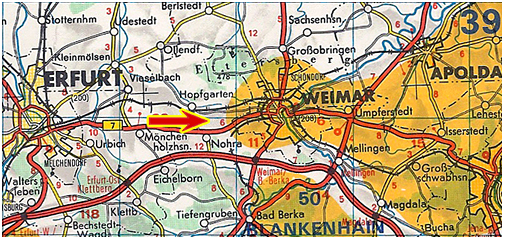
 The emergence of new regiments of combat helicopters equipped with Mi-24A from 1973 on and then additional regiments flying the Mi-24D from the late
1970's did not fail to worry NATO. One of these new regiments arrived at Nohra in 1979 and it of course attracted the attention of the Western military liaison missions.
A French team consisting of an officer and two non-commissioned officers of the French Air Force (Armée de l'Air) belonging to the French Military Liaison Mission
(FMLM) from Potsdam was the victim of a "blocking" (1) near that airfield some months later.
Here's the story, compiled thanks to the research Christian Handwerck conducted
in the Stasi archives and with the testimony of one of those directly involved, then Warrant Officer Jean-Yves Prat.
The emergence of new regiments of combat helicopters equipped with Mi-24A from 1973 on and then additional regiments flying the Mi-24D from the late
1970's did not fail to worry NATO. One of these new regiments arrived at Nohra in 1979 and it of course attracted the attention of the Western military liaison missions.
A French team consisting of an officer and two non-commissioned officers of the French Air Force (Armée de l'Air) belonging to the French Military Liaison Mission
(FMLM) from Potsdam was the victim of a "blocking" (1) near that airfield some months later.
Here's the story, compiled thanks to the research Christian Handwerck conducted
in the Stasi archives and with the testimony of one of those directly involved, then Warrant Officer Jean-Yves Prat.
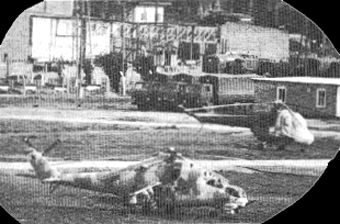 Les premières photos des Mi-24D du 336.OBVP furent réalisées dès le 26 mai 1979 par une équipe de la USMLM, alors que le régiment était en cours de transfert
depuis Berdyansk. L'équipe "Air" envoyée sur place suite à des informations fournies par TAREX (voir l'article "Allons chercher ces Foxbat !") nota également la présence
de "Hip-C" et "-E". On peut voir en arrière-plan de cette photo réalisée ce jour-là, un Mi-2 appartenant sans doute au 298.OVE BU également présent à Nohra.
© USMLM.
Les premières photos des Mi-24D du 336.OBVP furent réalisées dès le 26 mai 1979 par une équipe de la USMLM, alors que le régiment était en cours de transfert
depuis Berdyansk. L'équipe "Air" envoyée sur place suite à des informations fournies par TAREX (voir l'article "Allons chercher ces Foxbat !") nota également la présence
de "Hip-C" et "-E". On peut voir en arrière-plan de cette photo réalisée ce jour-là, un Mi-2 appartenant sans doute au 298.OVE BU également présent à Nohra.
© USMLM.
The first Mi-24D pictures of the 336.OBVP were taken by a USMLM team as early as the 26th May 1979 when the unit
was being transferred from Berdyansk. The Air Team responding to a TAREX notification (see "Let's go get Foxbat!") noted that "Hip-C" and "-E" were also present.
One can see in the background of this picture taken on that day, a Mi-2 probably from the 298.OVE BU also based at Nohra. © USMLM.
On January 11, 1980, air activity began around 9 a.m. at Nohra Airfield in Thuringia. The FMLM "big liaison vehicle" (Véhicule de Grande Liaison - VGL)
Mercedes 280E N°35 slipped into the area around 10:30 a.m., after a nocturnal preliminary approach using as discreet as possible pathways. Warrant Officer Jean-Yves
Prat remembers: «In 1980, the helicopter regiments, especially those equipped with Mi-24s, were gathering strength. Weimar-Nohra was an important airbase and new "Hind-D"
helicopters had been based there (2).
Hence, of course, our great interest for the activities at this particular base and its equipment. On January 11, 1980, we were in position, waiting to the west of the airfield.
Our crew consisted of Lieutenant Kerdranvat (now deceased), me and a third colleague whose name I have unfortunately forgotten. Everything was going well in the quiet - certainly too quiet.»
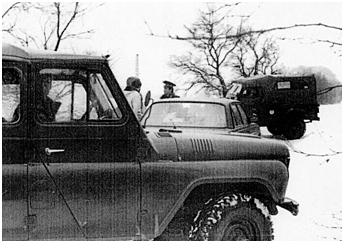 Un blocage en bonne et due forme. Le VGL était encadré par l'UAZ-469 du Major derrière et par une GAZ-69 devant.
© BStU.
Un blocage en bonne et due forme. Le VGL était encadré par l'UAZ-469 du Major derrière et par une GAZ-69 devant.
© BStU.
The French Mercedes blocked between the Major's UAZ-469 at the rear and a GAZ-69 in front.
© BStU.
 Un membre d'équipage de la MMFL en grande discussion avec le représentant de la Komendatoura . On peut imaginer le dialogue : "Vous voyez bien, que nous
n'étions pas dans une zone interdite." - "A d'autres, camarade !"
© BStU.
Un membre d'équipage de la MMFL en grande discussion avec le représentant de la Komendatoura . On peut imaginer le dialogue : "Vous voyez bien, que nous
n'étions pas dans une zone interdite." - "A d'autres, camarade !"
© BStU.
A FMLM crew member discussing with the Komendatura representative. One can imagine the conversation:
"You see, we were not in a restricted area." - "Give me a break, comrade!"
© BStU.
Too quiet, indeed, since the vehicle of the missionaries was spotted by Stasi agents at 11 a.m. The information was immediately relayed to the Soviets in charge at
Nohra and a group of soldiers went to the location where the Stasi surveillance vehicle was hiding to evaluate the situation. The latter was clear: spies! The Soviet
major in charge quickly organized an operation to block the mission crew. «We got flushed out by a group composed of several vehicles, GAZ, ZiL and one UAZ-469 with a major
aboard. The UAZ came upon us and, as usual, we tried everything possible to escape. The major jumped out of his vehicle and managed to grab onto the back of our VGL. But,
we had not seen this: I was driving and it is only when I looked in the rear-view mirror that I saw the 'Popov' hooked there. I immediately stopped the vehicle to avoid a serious incident
(3).
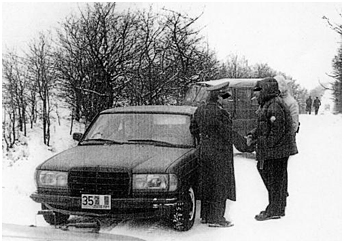 Le Major intrépide serre la main d'un Français. Tout est bien qui finit bien.
© BStU.
Le Major intrépide serre la main d'un Français. Tout est bien qui finit bien.
© BStU.
The intrepid Major shakes hands with a French. All's well that ends well.
© BStU.
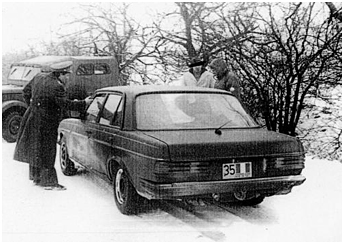 En attendant le représentant de la Komendatoura...
© BStU.
En attendant le représentant de la Komendatoura...
© BStU.
Waiting for the Komendatura representative...
© BStU.
I confirm that he was clinging on the back, contrary to what the romanticized Stasi report states, which says that the major interposed himself in front of the VGL to be
then caught on the front hood of the latter.»
The mission vehicle and crew were ultimately stopped on a dirt road between the villages of Ulla and Hopfgarten. The chief of the Komendatura arrived on location at 1 p.m.
«While waiting for his arrival, we tried to lighten the mood by offering cigarettes and cans of beer to the Soviet military on site, which was met with some success. The commander
reproached us for being in a permanently restricted area, which was not the case, but we were obviously behind Mission Restriction Signs
(4). After that, our crew chief refused
to sign the akt (5) and we were escorted out of the area around 1.45 p.m. The major then took us to a
parking lot near the Buchenwald concentration camp memorial to the
north of the field. It is there that I exchanged my forage cap for his cap. A cap that I keep preciously!» The Stasi report noted that the French and the major went to a nearby
restaurant to have a beer together. J.Y. Prat concludes:
«One thing is certain; we were close to disaster without knowing it. The major told us, I think, that he had been a little crazy to cling to the vehicle.»
notes
(1)
The term "blocking" was used by the French to describe the neutralization of a FMLM vehicle by the Soviets.
As a matter of fact, their vehicle was then unable to escape, hence the term "blocking".
(2)
The 336th Separate Combat Helicopter Regiment (OBVP) was formed on October 13, 1978 in Berdyansk, based on elements of the former
163rd Training Aviation Regiment (UAP) from the Navigation Higher School of Military Aviation (VVAUSh). The 336.OBVP was transferred to Nohra between
the 22nd and the 30th May 1979. In 1980, the following units were based at Nohra airfield:
- 336.OBVP (Mi-8 / Mi-24)
- 298.OVE BU (Mi-2 / Mi-8 / Mi-22)
- Other separate helicopter squadron? (Mi-2 / Mi-8)
(3)
We remembered the detention of a French crew for several days and attempts at political exploitation by the GDR authorities after the death (real or fictional)
of an NVA NCO as a result of an accident with one of our vehicles.
(4)
The mission restriction signs displayed a message written in English, French, Russian and German stating that passage of the "foreign military liaison missions" was forbidden.
They were placed by the Soviets and especially the Germans at locations that did not necessarily correspond to permanently restricted areas (PRA) or temporary restricted areas
(TRA). These signs were not recognized by the Allied missions. The only areas recognized as restricted were the PRAs and TRAs. Nearly 10,000 of these signs had been "planted" by
1980 and their number had reached about 30,000 when the Berlin Wall fell. About a hundred of them were destroyed by the three Allied missions each year.
(5)
The akt was a statement aimed at trying to inform the mission crew that it had violated the rules related to the missions. It was out of the question for the crews
to sign such a statement. Most of the time, they were released after a few hours.
 |
Plan du site - Sitemap |  |

